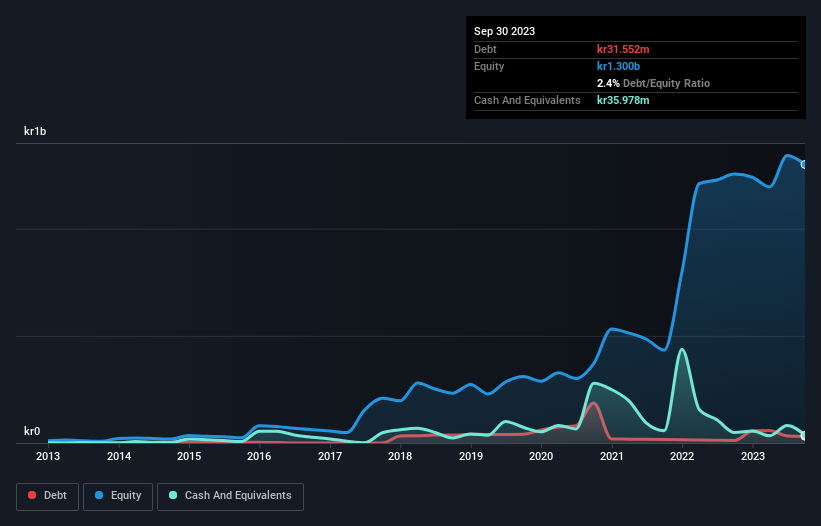Legendary fund manager Li Lu (who Charlie Munger backed) once said, 'The biggest investment risk is not the volatility of prices, but whether you will suffer a permanent loss of capital.' So it might be obvious that you need to consider debt, when you think about how risky any given stock is, because too much debt can sink a company. Importantly, Sivers Semiconductors AB (publ) (STO:SIVE) does carry debt. But the real question is whether this debt is making the company risky.
When Is Debt A Problem?
Debt and other liabilities become risky for a business when it cannot easily fulfill those obligations, either with free cash flow or by raising capital at an attractive price. In the worst case scenario, a company can go bankrupt if it cannot pay its creditors. While that is not too common, we often do see indebted companies permanently diluting shareholders because lenders force them to raise capital at a distressed price. Having said that, the most common situation is where a company manages its debt reasonably well - and to its own advantage. The first step when considering a company's debt levels is to consider its cash and debt together.
See our latest analysis for Sivers Semiconductors
What Is Sivers Semiconductors's Debt?
As you can see below, at the end of September 2023, Sivers Semiconductors had kr31.6m of debt, up from kr12.0m a year ago. Click the image for more detail. But on the other hand it also has kr36.0m in cash, leading to a kr4.43m net cash position.

How Strong Is Sivers Semiconductors' Balance Sheet?
We can see from the most recent balance sheet that Sivers Semiconductors had liabilities of kr90.5m falling due within a year, and liabilities of kr222.0m due beyond that. Offsetting these obligations, it had cash of kr36.0m as well as receivables valued at kr34.5m due within 12 months. So its liabilities total kr242.0m more than the combination of its cash and short-term receivables.
Given Sivers Semiconductors has a market capitalization of kr1.44b, it's hard to believe these liabilities pose much threat. However, we do think it is worth keeping an eye on its balance sheet strength, as it may change over time. Despite its noteworthy liabilities, Sivers Semiconductors boasts net cash, so it's fair to say it does not have a heavy debt load! The balance sheet is clearly the area to focus on when you are analysing debt. But it is future earnings, more than anything, that will determine Sivers Semiconductors's ability to maintain a healthy balance sheet going forward. So if you're focused on the future you can check out this free report showing analyst profit forecasts.
In the last year Sivers Semiconductors wasn't profitable at an EBIT level, but managed to grow its revenue by 47%, to kr249m. With any luck the company will be able to grow its way to profitability.
So How Risky Is Sivers Semiconductors?
By their very nature companies that are losing money are more risky than those with a long history of profitability. And in the last year Sivers Semiconductors had an earnings before interest and tax (EBIT) loss, truth be told. And over the same period it saw negative free cash outflow of kr165m and booked a kr73m accounting loss. Given it only has net cash of kr4.43m, the company may need to raise more capital if it doesn't reach break-even soon. With very solid revenue growth in the last year, Sivers Semiconductors may be on a path to profitability. By investing before those profits, shareholders take on more risk in the hope of bigger rewards. There's no doubt that we learn most about debt from the balance sheet. But ultimately, every company can contain risks that exist outside of the balance sheet. Case in point: We've spotted 2 warning signs for Sivers Semiconductors you should be aware of, and 1 of them is potentially serious.
Of course, if you're the type of investor who prefers buying stocks without the burden of debt, then don't hesitate to discover our exclusive list of net cash growth stocks, today.
New: Manage All Your Stock Portfolios in One Place
We've created the ultimate portfolio companion for stock investors, and it's free.
• Connect an unlimited number of Portfolios and see your total in one currency
• Be alerted to new Warning Signs or Risks via email or mobile
• Track the Fair Value of your stocks
Have feedback on this article? Concerned about the content? Get in touch with us directly. Alternatively, email editorial-team (at) simplywallst.com.
This article by Simply Wall St is general in nature. We provide commentary based on historical data and analyst forecasts only using an unbiased methodology and our articles are not intended to be financial advice. It does not constitute a recommendation to buy or sell any stock, and does not take account of your objectives, or your financial situation. We aim to bring you long-term focused analysis driven by fundamental data. Note that our analysis may not factor in the latest price-sensitive company announcements or qualitative material. Simply Wall St has no position in any stocks mentioned.
About OM:SIVE
Sivers Semiconductors
Through its subsidiaries, develops, manufactures, and sells chips, components, modules, and subsystems in North America, Europe, and Asia.
Good value with adequate balance sheet.
Market Insights
Community Narratives



